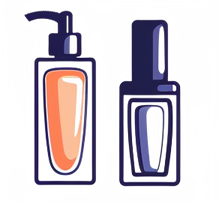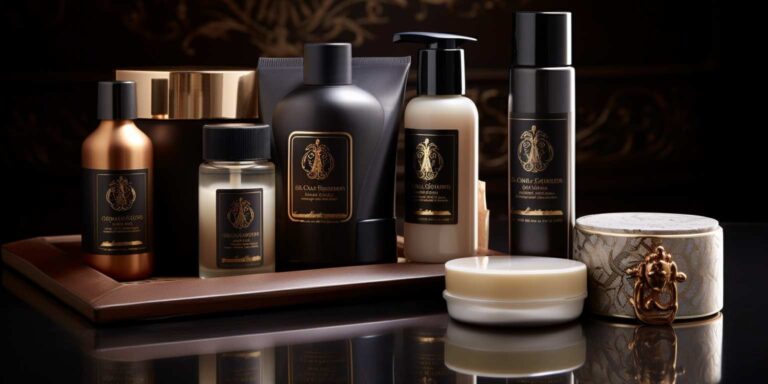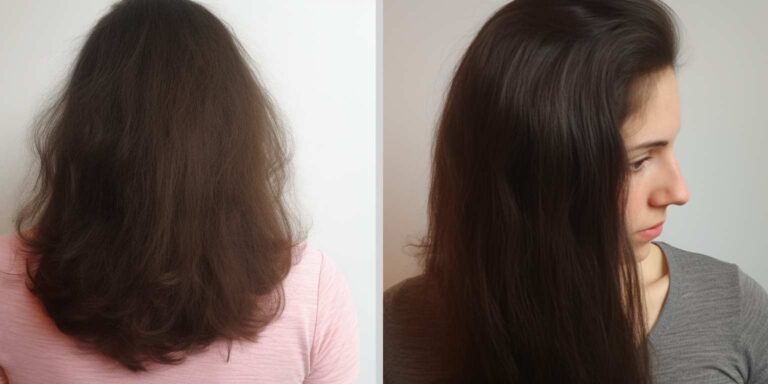Maximizing the benefits of purple shampoo
Firstly, let’s delve into how purple shampoo works. It’s all about color theory. The purple pigments in the shampoo work to neutralize yellow or brassy tones that can develop in blonde or silver hair over time. This happens because purple is opposite to yellow on the color wheel, so it cancels out any unwanted warm tones.
Now, let’s talk about how often you should use purple shampoo. While it can be tempting to use it every time you shampoo, doing so can lead to over-toning, which may result in a purple tint to your hair. Instead, aim to use purple shampoo once or twice a week, or as needed, to maintain color vibrancy without overdoing it.
Application technique matters. When using purple shampoo, start by wetting your hair thoroughly. Then, apply a small amount of purple shampoo to your palms and lather it gently into your hair, focusing on the areas where you see the most brassiness. Allow the shampoo to sit for a few minutes before rinsing it out. This gives the purple pigments enough time to do their job.
For those with severely brassy hair, you can try a purple shampoo mask. This involves leaving the purple shampoo on your hair for a longer period, sometimes up to 30 minutes, to really neutralize any unwanted tones. However, be cautious with this method as leaving purple shampoo on for too long can result in over-toning.
It’s also important to follow up with a good quality conditioner after using purple shampoo. While purple shampoo is great for toning, it can also be drying to the hair. A hydrating conditioner will help to restore moisture and keep your locks soft and healthy.
Tips for maximizing purple shampoo effect
Maximizing the effect of purple shampoo
Purple shampoo is a miraculous product for those looking to maintain their blonde or silver hair color and keep brassiness at bay. However, to truly maximize its effect, there are several tips and tricks you should keep in mind.
1. Choose the Right Product: Not all purple shampoos are created equal. Look for a shampoo with a deep purple hue as it will be more effective at neutralizing yellow tones. Additionally, opt for a sulfate-free formula to prevent further drying out your hair.
2. Frequency of Use: While it may be tempting to use purple shampoo every time you wash your hair, doing so can lead to over-toning and dryness. Instead, aim to use it once or twice a week, depending on your hair’s level of brassiness.
3. Dilute the Shampoo: If you find that your purple shampoo is too intense and leaves a noticeable tint on your hair, try diluting it with water before applying. This will help soften the tone and prevent your hair from looking overly purple.
4. Leave It On: To allow the purple pigment enough time to work its magic, leave the shampoo on for 3-5 minutes before rinsing it out. This extra time ensures that the brassiness is effectively neutralized, leaving you with a cooler tone.
5. Use a Hydrating Conditioner: Purple shampoo can be drying to your hair, so it’s essential to follow up with a hydrating conditioner to replenish moisture and keep your locks healthy and shiny.
6. Avoid Hot Water: Washing your hair with hot water can open up the hair cuticle and cause the purple pigment to rinse out more quickly. Instead, rinse with cool or lukewarm water to help seal the cuticle and lock in the color.
7. Rotate with a Clarifying Shampoo: Over time, purple shampoo can leave behind a buildup of product residue on your hair, leading to dullness. Incorporate a clarifying shampoo into your routine once a month to remove any buildup and restore shine.
8. Protect Your Hair from Heat: Heat styling tools like blow dryers and straighteners can further damage color-treated hair. To preserve your color and prevent brassiness, use heat protectant sprays before styling and avoid excessive heat.
Step-by-step purple shampoo application tips
If you’re looking to keep your blonde or silver hair looking vibrant and free from unwanted brassiness, mastering the art of purple shampoo application is essential. This specialized shampoo is a game-changer for those with light-colored locks, but using it effectively requires a bit of know-how.
Start by wetting your hair thoroughly. This may seem like a simple step, but it’s crucial for the shampoo to distribute evenly. Make sure your hair is completely saturated before moving on to the next step.
Once your hair is wet, it’s time to apply the purple shampoo. Dispense a small amount into your hands and work it into a rich lather. Focus on the areas where brassiness is most prominent, usually around the roots and tips.
Rinse your hair after letting the purple shampoo sit for a few minutes. Don’t leave it on for too long, as overuse can lead to a purple tint. Rinse thoroughly to ensure no residue is left behind.
For those dealing with stubborn brassiness, consider incorporating a purple conditioner into your routine. This can provide an extra boost of color correction while keeping your hair soft and manageable.
It’s important to note that frequency matters. While purple shampoo is effective, using it too often can lead to over-toning. Aim for once or twice a week, adjusting based on your hair’s individual needs.
If you find that your hair is still displaying unwanted warmth, consider a leave-in purple treatment. These products can be applied to specific areas, offering targeted color correction without affecting the rest of your hair.
Protect your hands during application. Purple shampoo can stain your hands temporarily, so wearing gloves is a simple yet effective precaution to avoid any unwanted discoloration.
Avoid using hot water when rinsing. Hot water opens up the hair cuticle, allowing the color to escape more easily. Opt for lukewarm or cool water to seal the cuticle and lock in the color-correcting benefits.
Lastly, invest in a quality purple shampoo. Not all formulations are created equal, so look for a product specifically designed for your hair color. Reading reviews and seeking recommendations can help you find the perfect match for your needs.
How often should you use purple shampoo?
Using purple shampoo can be a game-changer for those with blonde, silver, or highlighted hair. It’s the secret weapon against unwanted brassiness or yellow tones. But the burning question remains: how often should you use this miracle product without turning your locks into a shade of lavender?
The frequency of purple shampoo usage largely depends on your hair type, color, and individual needs. If you’re battling severe brassiness or have porous hair that tends to absorb color quickly, you might need to use purple shampoo more frequently, perhaps two to three times a week. On the other hand, if your hair only needs a slight tone correction, using it once a week should suffice.
A general rule of thumb is to start slow and observe how your hair reacts. Begin with once a week and gradually increase or decrease the frequency based on the results. Overusing purple shampoo can lead to over-toning, leaving your hair with a dull, ashy appearance. It’s all about finding the right balance.
Another factor to consider is the strength of the purple shampoo formula. Some products are more potent than others, so if you’re using a highly concentrated formula, you might need to use it less frequently to avoid over-toning.
Additionally, alternating between purple shampoo and your regular shampoo can help maintain the desired tone while preventing overuse. This way, you’re still getting the benefits of the purple pigment without risking any unwanted effects.
Choosing the right purple shampoo for your hair
Choosing the right purple shampoo for your hair can make all the difference in maintaining your desired shade of blonde or silver. With a plethora of options available in the market, it’s essential to understand what sets each product apart and how to select the one best suited to your needs.
Purple shampoo is specifically formulated to neutralize unwanted yellow or brassy tones in blonde, silver, or gray hair. The purple pigment in these shampoos works by counteracting the warm tones, leaving your hair looking cooler and more vibrant.
When shopping for purple shampoo, consider the following factors to make an informed decision:
| Factor | Considerations |
|---|---|
| Hair Type | Determine whether your hair is dry, oily, or normal, as this will influence the type of purple shampoo you need. Look for hydrating formulas if your hair tends to be dry, and opt for clarifying formulas if you struggle with excess oil. |
| Intensity | Consider the level of toning you require. If you have mild brassiness, a gentle purple shampoo may suffice. For more stubborn tones, opt for a stronger formula or one that can be left on for longer periods. |
| Ingredients | Check the ingredient list for nourishing additives such as keratin or arginine to keep your hair healthy and strong. Avoid products containing sulfates or parabens if you prefer a more natural option. |
| Price | While price shouldn’t be the sole determinant, it’s essential to find a purple shampoo that fits your budget. There are excellent options available at various price points, so explore different brands and formulations. |
Additionally, don’t forget to read reviews and seek recommendations from friends or hairstylists who have experience with purple shampoos. Their insights can help you narrow down your choices and find the perfect product for your hair.
Once you’ve selected a purple shampoo, incorporate it into your hair care routine by using it regularly, but not excessively. Overusing purple shampoo can lead to a buildup of pigment, resulting in dull or ashy-looking hair.
Pre and post purple shampoo care
Pre and post purple shampoo care
When it comes to maintaining beautiful blonde or silver hair, purple shampoo is a go-to product for many. However, to ensure the best results and to keep your locks healthy and vibrant, it’s essential to pay attention to both pre and post purple shampoo care.
Pre-purple shampoo care:
| Step | Description |
| 1 | Prep your hair: Before applying purple shampoo, make sure your hair is thoroughly wet. This helps in evenly distributing the product and prevents it from staining your hair. |
| 2 | Protect your skin: Purple shampoo can be drying to the skin, so it’s essential to protect your hands and scalp by wearing gloves or applying a protective barrier cream. |
| 3 | Adjust frequency: Depending on your hair type and color, adjust the frequency of purple shampoo use. Overuse can lead to dryness and dullness, so it’s crucial to find the right balance. |
Post-purple shampoo care:
- Condition: After rinsing out the purple shampoo, follow up with a nourishing conditioner. This helps in restoring moisture and keeping your hair soft and manageable.
- Avoid heat styling: Purple shampoo can make your hair more susceptible to damage from heat styling tools. Try to minimize the use of blow dryers, straighteners, and curling irons to maintain the health of your hair.
- Use a leave-in treatment: Incorporating a leave-in treatment into your post-purple shampoo routine can provide additional hydration and protection for your hair.
- Protect from the sun: Sun exposure can cause brassiness in blonde and silver hair, so it’s essential to protect your locks with a hat or UV-protectant hair products.
Troubleshooting common purple shampoo issues
In the world of hair care, purple shampoo has become a staple for those with blonde, silver, or highlighted hair. It’s the go-to solution for keeping those unwanted brassy tones at bay. However, despite its popularity, users often encounter common issues when using purple shampoo. Let’s delve into some of these problems and how to troubleshoot them effectively.
Issue 1: Staining
One of the most frustrating problems with purple shampoo is the potential for staining. If you’ve ever ended up with purple streaks on your hands or bathroom surfaces, you’re not alone. The key to preventing staining is proper application. Make sure to thoroughly rinse your hair and hands after use. Additionally, consider using gloves during application to avoid direct contact with your skin.
Issue 2: Over-toning
While purple shampoo is excellent for neutralizing brassiness, it’s possible to overdo it. If you notice your hair taking on a slightly gray or lavender hue, you’ve likely fallen victim to over-toning. To remedy this, switch to a milder purple shampoo formula or dilute your current shampoo with a bit of regular shampoo to lessen the intensity of the purple pigment.
Issue 3: Dryness
Some users experience dryness or brittleness after using purple shampoo frequently. This occurs because purple shampoo contains sulfates, which can strip the hair of its natural oils. To combat this, look for sulfate-free purple shampoos or follow up with a hydrating conditioner to restore moisture.
Issue 4: Ineffectiveness
Perhaps you’ve been using purple shampoo diligently but haven’t seen the desired results. This could be due to product buildup on your hair, preventing the purple pigment from penetrating effectively. To address this, use a clarifying shampoo once a week to remove any buildup before using purple shampoo.
| Common Purple Shampoo Issues | Troubleshooting Tips |
|---|---|
| Staining | Rinse thoroughly after use and consider wearing gloves. |
| Over-toning | Switch to a milder formula or dilute with regular shampoo. |
| Dryness | Opt for sulfate-free options and follow up with conditioner. |
| Ineffectiveness | Use a clarifying shampoo to remove buildup before application. |







